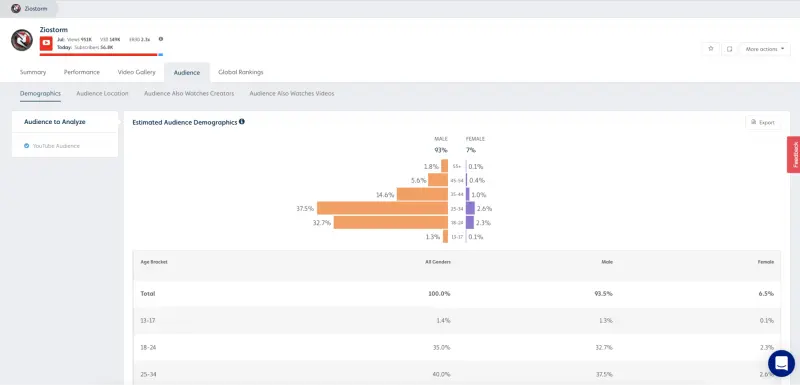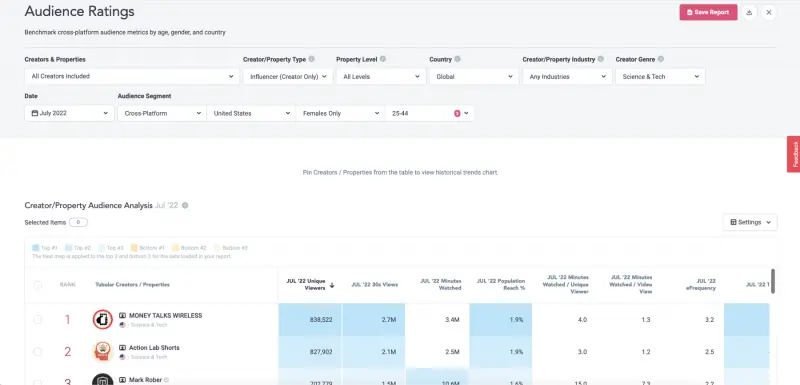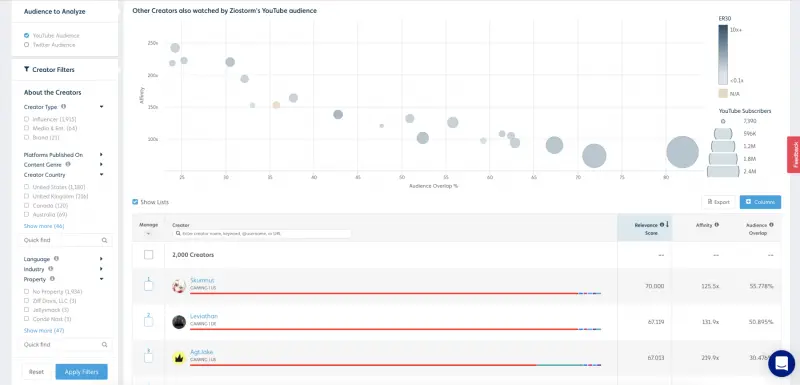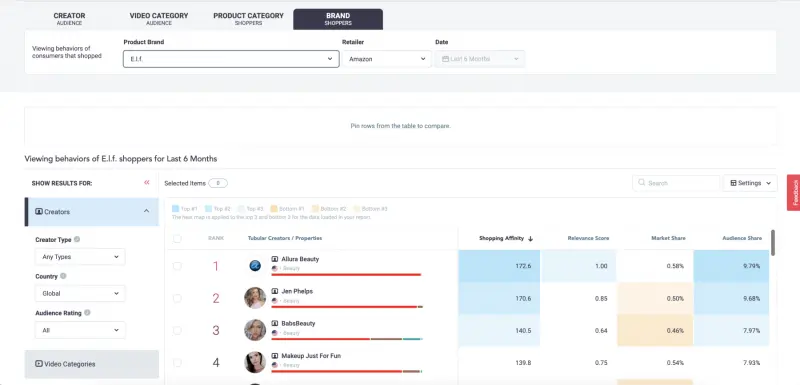
Overview
There are roughly 500 hours of video uploaded to YouTube every minute, although that’s kind of an estimate. We got that number from a two-year-old article, so who knows what the number might be now? Actually, there might be some people who know: the folks who created and maintain the video analytics engine at Tubular Labs.
Founded in 2012, the story goes, Tubular was conceived by its founder, Rob Gabel, as a way to index and analyze what was already looking like a mountain of data underneath videos on YouTube. Ten years later, that mountain turns out to have been a mere molehill, with YouTube growing at exponential rates—while other platforms like Instagram, TikTok, Facebook, and even Twitter have added to the social video landscape.
Over the first decade of its existence, Tubular has attracted a veritable who’s who of blue-chip customers: Mattel, Amazon, Condé Nast and Activision are some big names that aren’t surprising. More surprising? YouTube and Facebook and TikTok rely on Tubular for data about the videos they’re all hosting! Clearly there’s something in here beyond reach, likes, comments, and shares.
And of course there is: Tubular’s machine learning algorithms give them deep insights at a scale no team of humans could accomplish in a lifetime. It isn’t just that they’re indexed and categorized; audiences are analyzed, their behaviors and brand affinities uncovered. It only stands to reason, then, that Tubular’s data can be used by brands as an influencer Discovery tool, as well. When you can learn as much as you can about the videos and audiences indexed by Tubular, it’s a simple matter of asking, “Who made this video?”
OK, it’s a bit deeper than that. Read on.
Tubular Labs Review:
Pricing
Tubular’s offering works like any SaaS platform, though they don’t make the details of its pricing public. It is likely custom tailored based on individualized factors, so your best bet is to contact them directly to scope out a solution for you.
The Details
Did we mention all the data? Probably the first thing you’ll do when you log into Tubular is to search for a creator you already know pretty well. And if that wasn’t your plan, you should do it that way: when you start learning things you didn’t already know or didn’t know you could know, it underscores how powerful the platform is. Taking a look at a creator’s profile on Tubular gives you quite a bit of information—all of which is timestamped, so you can actually get some context for what you’re looking at. Here’s what this looks like in action:
Digging into the performance of a creator, you can slice and dice the graph in a number of ways. You can view a few metrics here—Views, Engagements, Uploads, and Followers/Subscribers—and see the aggregate of them across all that creator’s channels, or any ones you want to look at specifically. The range of time can be changed, and even the interval of time from data point to data point. But where this gets really handy is the ability to add in other creators to see a visual comparison of their metrics. In the screenshot above, there’s no question who’s getting the most engagement. The coolest part of this graph is that you can click anywhere along it—maybe you want to see what’s behind the spike in activity—and you’ll be given a pop-up list of all the videos that added to the total that day, organized in descending order.
Another way to find influencers is by starting with content. To do that, it’s a simple matter of searching through a mere 1.1+ billion videos that represent the last 90 days of activity. You can search with keywords and then refine your results with the dozens of filters available. But there’s an even easier way: just search whatever the topic or hashtag is to find relevant content. Then you can start following the numbers to find the most popular creators. Maybe your search term shows most of the content is happening on TikTok. In that case you filter to show only TikTok creators, and then sort the list with Tubular’s “Top Creators” feature. Right there, you can see a vastly narrowed list that you can work with.
You’ll see that there are a number of stats given around video views, and this can get pretty granular. Beyond just seeing how many views a video gets, Tubular is able to delve into how long people actually watch, calculating average watch time per view. This is helpful for rate negotiations: it’s cool if an influencer has 100,000 followers, but if he’s only getting an average 15,000 views (and people aren’t watching but half of it), you’re armed with some really good intel coming into that deal. There’s also some basic audience demographic information you can get here, but as you’ll see Tubular can go far deeper than that with the people who are viewing videos.
They’ve introduced a new module called “Audience Ratings,” which uses their own machine learning algorithms to learn more about the audiences watching the videos Tubular has indexed. Enter the parameters of an audience you’re after to see what accounts resonate with them, and you’ll get some very cool audience metrics that give a more complete picture of the audience. You’ll understand how many unique views there were, which is important: one person watching a video twice counts as two views, but you’ve still only reached that one person. But then you’ll also get a metric for “quality” views, which is how many of those views lasted for at least 30 seconds. You’ll see total minutes watched, as well, and this is a good place to say you can use this module for competitive research. These aren’t solely influencer accounts you can look at; other companies, including your own, are all fair game, and looking at all these stats with your account mixed in, you’ll really get a feel for how you’re performing relative to your competitors. This is all laid out quite nicely, with color coded squares of data showing you the top rankers without the need to sort columns.
Other data you can get about an influencer’s audience includes looking into what other videos or accounts they watch. This is useful for getting lookalike accounts of influencers you’d like to work with, but for whatever reason you can’t. Maybe they’re working with another company, maybe they’re just too expensive. Either way, Tubular has you covered with a full list of other accounts similar to the one you wanted, and you’ll even get a specific audience overlap number (i.e. people who appear in both audiences).
If you wanted to see specific videos that your target audience is watching you could do that, too. On its own, this feature is a nice-to-have, but we’re told it will soon be paired with functionality that makes it a need-to-have: cross-referencing these specific videos they’ve watched with topics they’re interested in. Getting this specific is the difference between knowing that an audience has an affinity for beauty products and knowing you can split that audience into one that’s into hair care and another that’s into skincare. This is well into its testing phase, and feedback has been overwhelmingly positive, so expect this to be available soon (if it isn’t already).
What is definitely available now, and is the kind of tool that can be a real game changer for brands, is the consumer insights reporting you can get out of Tubular. The platform’s tied into Amazon and Walmart sales data. You can use it to search any brand; Tubular combs through all the purchases of that brand and cross-references it with their viewing habits on YouTube. In this way, you’ll find out the influencers they like. But more than that: you'll know just how much more likely they are to buy from the brand you’re searching for than the average viewer/consumer.
In the screenshot above, for example, you can see that the average viewer of videos from beauty influencer Jen Phelps is 170x more likely to buy E.l.f. Products. Knowing this shopping affinity is a huge deal for brands. If you’re E.l.f. Products, anyway, you know where to announce your latest products.
Conclusion
It’s hard to communicate just how expansive Tubular Labs’ platform really is. The sheer volume of data it has indexed is mind-boggling. Using the “500 hours of video uploaded per minute” metric yields 262.8 million hours of video every year (which year only has 8,760 hours in it). And here’s Tubular Labs, which is only indexing the good stuff, ingesting 9 million videos per day while maintaining a database of 28 million influencers. Just that on its own is an achievement. Add to that all the audience and consumer insights, and you can see why Tubular is the go-to tool for analyzing social videos for so many brands—and channels.
-
Features
-
Ease of Use
-
Reporting









